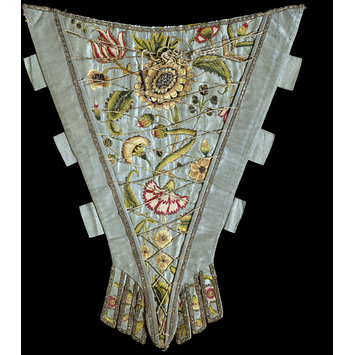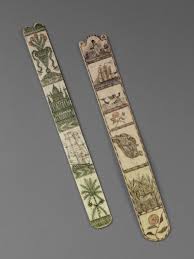Like most historical novelists, I’ve  spent
spent  much of my research time immersed in the everyday life of an earlier century, and my vocabulary has expanded. It has expanded to include words that most people have never heard of. As a novelist, this was brought home to me, when I had one character stab another character ‘in the stomacher’.
much of my research time immersed in the everyday life of an earlier century, and my vocabulary has expanded. It has expanded to include words that most people have never heard of. As a novelist, this was brought home to me, when I had one character stab another character ‘in the stomacher’.
Of course my editor knocked off the ‘er’ on the end, thinking it was a misprint, and I meant stomach. It wasn’t a misprint – that was actually what I meant. A ‘stomacher’ is a decorative triangular panel, usually separate from, but designed to fit within, a woman’s 17th or 18th century bodice. It is worn to fill the space between the front edges of a woman’s open gown, and was often the most decorative part of the dress. Here are some beautiful examples with embroidered flowers.
Sometimes, the stomacher would be filled by a ‘busk.’ (Editor: do I mean ‘bust’? Me – no, I do mean ‘busk’.)

18th Century portrait by Roslin, showing stomacher
A busk is a wooden, bone or leather panel designed to keep the stomacher stiff and flat. Busks were used right up until the Victorian era, and were often decorative, with carved or incised decoration. They were also used within the stays, depending on the era. Yes, ‘stays.’ They are a sort of corset.
I know all these words. They are really familiar to me, but my poor reader? If they don’t read much historical fiction, they are probably baffled.
Which brings me to deadly sin no 4. Period words should be clear either from the context, or you should consider including a glossary. When someone punched my character in the ‘stomacher’, although it was clear to me what was happening, the editor was right. Most people would have thought it an error or misprint. Which left me with the option of explaining that the stomacher, with fitted busk, would have protected the wearer. Again, not a very neat option, if you are having to explain what words mean. It holds up the action, and becomes more like a lecture than fiction. I did the sensible thing and cut it. Actually, I re-wrote the whole scene.
It is good to use historical words occasionally to give a flavour – e.g ‘she climbed into the brougham, and the driver set the horses going.’ In this example the context makes the meaning clear. The same caveat applies to words of another, or earlier culture (e.g. Ancient India, Medieval Byzantium). If you want to use a foreign word for effect, then look for those words where the meaning is blindingly obvious, or provide a glossary.
The glossary itself should only be the words the reader can’t fathom for himself. The shorter the better – a long glossary can really put the reader off reading the book, as they know they might have to stop the story to tern to the end to look things up.

Left: Carved decorative busks. Worn close to the heart, these were often carved with symbols of love, or told a story of a life or journey.
Brougham – A brougham was a light, four-wheeled horse-drawn carriage built in the 19th century.
You might also like:
Deadly Sin 1 – Melodrama
Deadly Sin 2 – Purple Prose
Deadly Sin 3 – Stuck in the Past
I recommend: Carla Nayland’s post on Archaic Terminology in Historical Fiction
Picture Links:
https://honieu.wordpress.com/2010/10/28/18th-century-rococo-era/

It’s difficult to know what should be fairly common knowledge and what is more specialist. Some people, like me, might know what a stomacher is, but have no idea about a busk. Others might know both or neither.
Personally, I don’t mind having to look something up, but only if it’s one thing. If I have to keep flicking to a glossary the back to find out what a word means I’ll lose interest in the story. I don’t even like doing that when I’m reading non-fiction.
Good point, April. I don’t much like glossaries myself, but I’ve had several readers write to me and ask me to consider using one. If I provide one, then those who want to can flip to the back of the book, and those who don’t want it will simply ignore it. You’re right about how different people know different words too – every reader is different and has a different reading background. Wish I was a mind reader! Thanks for stopping by and commenting.
Thanks for another interesting post, Deborah.
The overuse of archaic words in Georgette Heyer’s “My Lord John” ruined the book for me. It had the longest glossaries I’ve ever encountered in a work of fiction. It’s rather a tiresome process to keep flicking back and forth to discover the meaning of a word. For this title I gave up checking and guessed the meanings!
Although I’d admired the Ms Heyer on the one hand for her authenticity and research, I would’ve admired her much more had she simplified the language. The narrative would’ve benefited greatly from it.
By the way, is the Roslin portrait of Madame de Pompadour?
Hi Phil,
I haven’t read My Lord John, but you’ve certainly put me off it. The Roslin portrait is called ‘Portrait of an Unknown Lady’, so I guess we don’t know. Though you’re right, other paintings of Madame de Pompadour look quite similar to this one. The other possibility is that it’s Françoise de Sévigné, Countess de Grignan.
On the Glossary conundrum: Somebody I know suggested that the unknown words in fiction could be linked to the glossary in ebooks, so the reader could click through. The only disadvantage to this is that the word shows up as a highlight, which makes it stand out from the rest of the text – so obviously not a good idea. If anyone has an answer to this – please let me know!